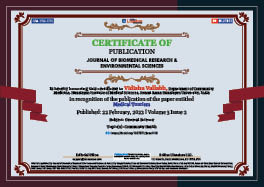General Science . 2022 February 22;3(2):179-180. doi: 10.37871/jbres1418.
Medical Tourism
Deep Shikha and Vidisha Vallabh*
Transnational medical travel, widely quoted as medical combines health care with leisure travel. Asia-Pacific is the leading contributor to the global market revenue in medical tourism and the global turnover is expected cross over USD 31.21 billion by 2026. With protracted and expensive visa and medical services patients seek sophisticated but inexpensive healthcare unavailable in their country. These issues are capitalized by many developing and developed countries like Thailand, India, Malaysia and Singapore by the virtue of their marked cost differentials, economical airfare, advanced medical care, favourable health care infrastructures, destination competitiveness, service quality, travel and entertainment facilities, making them a popular medical destination.
With an annual growth rate of 30%, and varieties of treatments (AYUSH), medical tourism in India is booming; cost-effective skilled labour force, state-of-the-art medical technologies and medical services and widespread use of English give patients a throughout smooth and seamless treatment experience.
But for all its advantages, transnational medical travel has several draw backs associated that are not usually well thought-out. Variation in health care regulations are common especially in developing nations, giving a wide room to health professionals in terms of medical education and certifications; patients even may get managed by inappropriate medical personnel or undergo an unsuitable procedure. With economics playing a major role in deciding the medical destination, patients coming in for a low-cost procedure may end up paying hefty sums as hidden costs for further investigations. In case of a complication, negligence or incompetence, the cost and toil of health re-evaluation or litigation in worst cases might turn out to be nightmarish as the person is in the legal jurisdiction of the errant nation. With visa being non-obligatory for communicable diseases, transnational medical travel poses as a hazard in spread of certain diseases. Catering to mostly international travellers and upper middle-class nationals, medical tourism challenges the local health care providers by warping the local health care delivery systems, inciting economic, ethical and social questions of vital importance.
Though the government policy on subsidized health care for international visitors and for ordinary citizens are contradictory, government sector is committed to fill this void. The nationals plans (X,XI,XII) and National Health Bill promoted by GOI welcomed medical tourism, introducing public-private partnership in healthcare. This privatization and commercialization was accompanied by substantial subsidies in land, medical equipment and medicines will transform the face of medical care. Better infrastructure and compensations along with untroubled workplace environment has attracted qualified and enthusiastic health professionals from public sector too.
With newer nations joining the wagon, risks in this sector are inescapable. These risks though invite vulnerability, they also drive the health care industry in searching newer avenues in terms of technology and innovation. To strengthen the services not only good medical education but also soft-skill development especially skills concerning ethics and subculture is of vital importance for massive success and generous turnover. An increasing competition also propels the government and private sector to focus on increasing the number of medical tourists while ensuring the quality of health care services and their cost-effectiveness without raising ethical issues.
Medical tourism, a diamond with facets both dull and bright, needs to be regulated and mobilized under steady policies to reap maximum rewards for both the provider and the beneficiaries [1-11].
References
- Gupta V, Das P. Medical Tourism in India. Clinics in Laboratory Medicine. 2012;32(2):321-325. https://bit.ly/36pzBYd
- McKinnon BJ, Bhatt N. Cochlear implants and medical tourism. Cochlear Implants Int. 2010 Sep;11(3):125-32. doi: 10.1002/146701010x486444. Erratum in: Cochlear Implants Int. 2010 Dec;11(4):241. PMID: 21756681.
- Sultana S, Haque A, Momen A, Yasmin F. Factors affecting the attractiveness of medical tourism destination: an empirical study on India- review article. Iran J Public Health. 2014 Jul;43(7):867-76. PMID: 25909055; PMCID: PMC4401052.
- Meghani Z. The ethics of medical tourism: from the United Kingdom to India seeking medical care. Int J Health Serv. 2013;43(4):779-800. doi: 10.2190/HS.43.4.k. PMID: 24397239.
- Qadeer I, Reddy S. Medical tourism in India: perceptions of physicians in tertiary care hospitals. Philos Ethics Humanit Med. 2013 Dec 17;8:20. doi: 10.1186/1747-5341-8-20. PMID: 24345280; PMCID: PMC3901785.
- Sengupta A. Medical tourism: reverse subsidy for the elite. Signs (Chic). 2011;36(2):312-9. doi: 10.1086/655910. PMID: 21114076.
- Runnels V, Turner L. Bioethics and transnational medical travel: India,"medical tourism," and the globalisation of healthcare. Indian J Med Ethics. 2011 Jan-Mar;8(1):42-4. doi: 10.20529/IJME.2011.014. PMID: 22106599.
- Smith K. The problematization of medical tourism: a critique of neoliberalism. Dev World Bioeth. 2012 Apr;12(1):1-8. doi: 10.1111/j.1471-8847.2012.00318.x. PMID: 22420447.
- Connell J. A new inequality? Privatisation, urban bias, migration and medical tourism. Asia Pac Viewp. 2011;52(3):260-71. doi: 10.1111/j.1467-8373.2011.01454.x. PMID: 22216475.
- Murray SF, Bisht R, Pitchforth E. Emplacing India's "medicities". Health Place. 2016 Nov;42:69-78. doi: 10.1016/j.healthplace.2016.08.004. Epub 2016 Sep 28. PMID: 27693748.
- Idowu EO, Adewole OA. Spectrum of neurosurgical complications following medical tourism: challenges of patients without borders. Afr Health Sci. 2015 Mar;15(1):240-5. doi: 10.4314/ahs.v15i1.31. PMID: 25834554; PMCID: PMC4370124.
Content Alerts
SignUp to our
Content alerts.
 This work is licensed under a Creative Commons Attribution 4.0 International License.
This work is licensed under a Creative Commons Attribution 4.0 International License.








